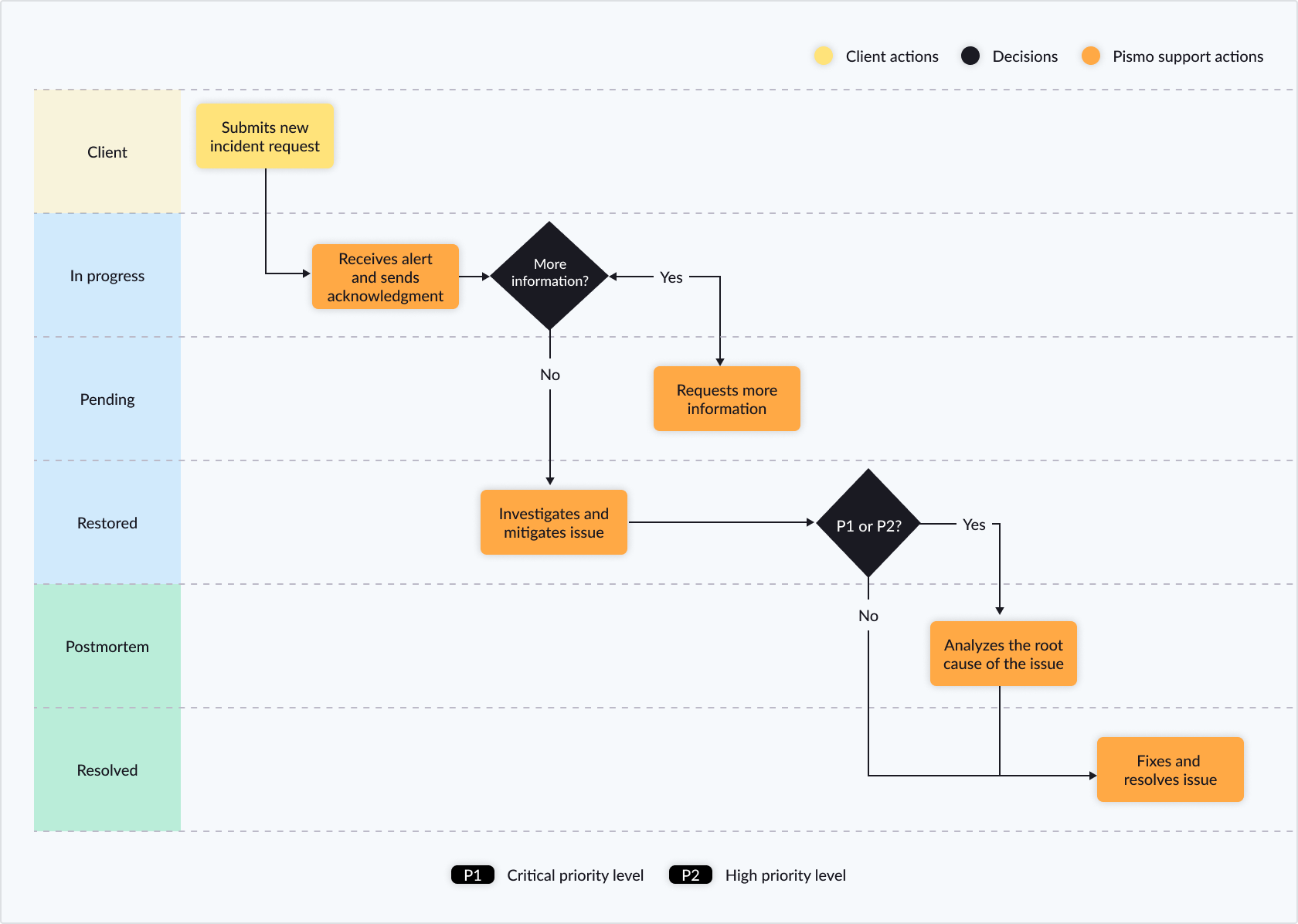Incident lifecycle
This page describes the incident lifecycle and Pismo's role in managing and resolving incidents. It also highlights the importance of providing a specific and detailed description of your issue so Pismo can understand and resolve your issue as soon as possible.
When resolving an incident, Pismo will focus on two key tasks:
- Mitigation: Take immediate steps to restore normal platform operations.
- Resolution: Address any negative effects caused by the incident—such as correcting inaccurate balances or data—and implement changes to prevent the issue from happening again.
Pismo automatically escalates every incident request, no matter what the severity is. It is Pismo's responsibility to evaluate the incident and determine its priority based on the impact that it has. To help ensure that your issue is evaluated properly, it is important to provide a specific and detailed description of your issue (for more information, refer to Describing an issue). To report an incident, refer to Open a service request.
The following image provides an overview of the incident lifecycle workflow.

Incident resolution process
After your request is submitted and acknowledged, the resolution process proceeds as follows:
- A new service request receives the status In Progress. You can add comments during this stage, to provide evidence or additional information.
- When the support team has mitigated the issue, they update the status of the request to Restored.
- The support team may decline an incident request if:
- They are unable to reproduce the reported issue.
- The issue is outside the agreed-upon parameters.
- The issue is caused by a third party or is otherwise beyond Pismo's control. (However, the support team will clearly communicate the reason for declining an incident request.)
- The status of a declined incident is Resolved with the resolution Won’t Do.
- When the support team has resolved the issue and corrected any negative effects, they update the status of the request to Resolved.
- If you are not satisfied with a resolution, be sure to reopen your request instead of submitting a new one.
- For resolved P1 and P2 incidents, Post Mortem status indicates that Pismo is investigating how and why it occurred.
- Root Cause Analysis (RCA) refers to the process that the Pismo engineering team follows after an incident is resolved. This process determines why the incident occurred and develops the necessary steps to ensure that it doesn't happen again. Details about the root cause that contain sensitive or internal information may be omitted.
- Incidents with Pending status indicate that the support team needs more information or approval to proceed with the planned actions. Pending requests move automatically to Resolved status after 5 days without activity.
- Closed status represents that the incident is fully concluded and cannot be reopened.
The following table describes the available priority levels for an incident.
| Incident priority | Description |
|---|---|
| P1 - Critical | Severe impact:
|
| P2 - High | Significant impact:
|
| P3 - Medium | Partial degradation of services or financial processes. |
| P4 - Low | Minor impacts to platform performance. |
Pismo aims to restore normal service operation as quickly as possible. In general, the on-call support team acknowledges all incident requests within 15 minutes. Mitigation can take up to four hours for critical incidents, and up to three days for lower-priority incidents.
Incident request status
The following table describes the request status values.
| Status | Description |
|---|---|
| New | Request is awaiting service. This is the status when a request is first created. |
| In progress | Resolution is in progress. |
| Pending | Waiting for more information from you. After answering the questions, you must click To Do to submit your answers. If no action is taken within 240 hours, the request moves automatically to Resolved status. |
| Reopened | Proposed resolution to a request (in status Restored, Validating, or Resolved) was not satisfactory, and the issue is reopened. |
| Restored | An incident has been addressed, restoring normal operation. |
| Resolved | Incident has been resolved. At this point, you can either close the request or select Reopened, to reopen it if you are not satisfied. If no action is taken within 120 hours, the request moves automatically to Closed status. |
| Post Mortem | A workaround has resolved an incident and Pismo is developing a more permanent solution. |
| Closed | Issue has been resolved to your satisfaction. |
Incidents identified internally
Incidents that are discovered internally are reported on the Pismo operations status page, along with updates about its resolution. You are welcome to open an incident even if there's already an incident posted on the status page, in case you encounter any other impacts.
Scheduled maintenance activity
Pismo posts notification messages in advance of all scheduled maintenance on the on the operations status page. In case of an incident related to a pre-communicated maintenance activity, Pismo reserves the right to decline the request but will provide an explanation for the decision.
Updated 16 days ago